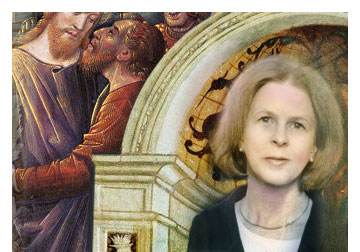One problem with understanding sexuality in the past is that...
...it takes a lot of imagination, and an open mind, to recognize that past cultures and subcultures have thought differently from us about sexuality. Most obviously, we don't find that many folks in the Roman Empire dated, and then chose life partners to marry. Marriages were generally arranged without reference to any couple's personal compatibility. And many of the early Christian writers we're likely to read thought that marriage was a bad idea. If we project our own cultural understandings and norms of sexuality onto the past, we're liable to misunderstand what's going on, either passing negative judgment on it, or constructing a false narrative that appeals to us. Thus those of a liberal persuasion will often assume that the past was unenlightened and repressive and patriarchal, and will approach the sources (if they read them at all) through the lens of disrespect. Those of a conservative persuasion will often construct the past as a place where their own "traditional" norms of sexuality were always honoured.
Another potential obstacle to an accurate understanding of sexuality in early Christianity is that we often underestimate the range and diversity of attitudes and practices, even in the same place and time. People didn't all think alike then any more than they do today. Some early Christian writers can give us the impression that they were saying exactly what the entire Church thought; but don't believe it.
Still another problem we have to deal with is that social phenomena are all interrelated, and when we abstract a single dimension of human experience, such as sexuality, we tend to distort its social function and meaning.
Contested premises
 Here are some questions that frequently recur.
Here are some questions that frequently recur.
- To what extent are gender and sexuality biological givens, and to what extent are they culturally constructed? Under the influence of social scientists, most historians have probably tended to emphasize the differential construction of gender and sexual identity in different societies, and among different individuals. Our answer to this question is likely to affect how we read ancient texts.
- Most surviving early Christian documents are written by educated men, many of them celibate. Can they be read "against the grain" in a way that allows marginalized or repressed voices to be heard?
- Early Christians weren't interested in all the things that we're interested in. They often write a great deal about things that we're no longer concerned about, and write very little about things that we'd love to know. Does the very act of asking modern questions of ancient texts distort our understanding of them?
(The image above right of a painting by Jean-Joseph Thorelle, d. 1889, is taken from Wikimedia Commons free media repository at https://commons.wikimedia.org/wiki/File:Jean-Joseph_Thorelle-Adam_et_Eve_au_paradis_terrestre.jpg.)
Peter Brown
Peter Brown, a retired history professor at Princeton, wrote an important survey history of Christianity and sexuality in 1988 called The Body and Society. (A twentieth-anniversary edition was published in the spring of 2008.) He built on the insights of the social sciences and recent historians of sexuality such as Michel Foucault, and carefully read early Christian theology (before the fifth century) in its own context. He recognized the inadequacy of saying, as many did say, that Christianity introduced sexual repression into a sexually  innocent, or perhaps sexually indulgent, world. He tried something else.
innocent, or perhaps sexually indulgent, world. He tried something else.
► Brown begins the book by analyzing the variety of attitudes towards sexuality in the pagan Roman world of the second century C.E. While there were many social variations, a general pattern was that sex was understood as serving the common good — that is, it was understood that the body should serve society (hence Brown's title). Sex served reproduction and was therefore necessary for social continuity, stability, and strength in the family and community. One significant school of thought, with considerable influence among social leaders, including many Christians, was Stoicism, which saw the body as something to be administered, like a well-ordered city; and moderation was a virtue in sexual matters as in all other things.
►Then he looks at the Christian world. Most Christians shared the sense that sex was a social good, but not all felt obliged to do what was good for society, since their consuming commitment was to God. The result was a variety of approaches.
- Clement of Alexandria in the early third century took an approach rather like that of the Stoics, though he was rather more warm-hearted.
- At another extreme were those who were thoroughly unhappy with the worldly status quo, and had no intention of submitting their bodies to serve society. They practiced radical sexual renunciation.
- Still others, such as the desert fathers and mothers, treated their bodies as an instrument for their salvation. In claiming their bodies for themselves rather than putting them to the service of the state, they were making a revolutionary statement for freedom.
- Still another way was that of Origen, who understood that the body was not something objectively given but something that could be changed by and towards our true self, which was neither male nor female.
Other views
Here are two other studies of Christianity and sexuality before the fifth century.
Elaine Pagels, also of Princeton, writing in Adam, Eve, and the Serpent (N.Y.: Random House, 1988), had a somewhat narrower focus that Brown's but came to similar conclusions. She proposed that Christians learned from their  Scriptures a sense of moral freedom and moral responsibility that was quite different from the pagan assumption that people existed to fit into the social scheme of things. The Christian ascetics were refusing to sanction traditional pagan social and family values, and their sexual discipline was the key to their project of creating a new society of moral equality.
Scriptures a sense of moral freedom and moral responsibility that was quite different from the pagan assumption that people existed to fit into the social scheme of things. The Christian ascetics were refusing to sanction traditional pagan social and family values, and their sexual discipline was the key to their project of creating a new society of moral equality.
Aline Rousselle, in Porneia: On Desire and the Body in Antiquity (NY: Basil Blackwell, 1988), made use of ancient medical manuals, which took the view that, for men, sex was debilitating, since it deprived them of vital life force, and for women, sexual pleasure was medically of no importance. The purpose of sex was reproduction. Accordingly, girls were frequently subjected to preadolescent marriages so that they could get on reproducing as soon as possible. Given these values, the sexual lives of both pagan men and women were generally unfulfilling. For the Christian ascetics, therefore, sexual renunciation didn't mean sacrificing something enjoyable and fulfilling, but escaping something restrictive and rather unpleasant. But, unfortunately, the men could not leave behind their social conditioning that led them to look down on women, and the women could not leave behind their sense of social inferiority; these conditionings were amplified by the ascetics' confrontations with lust. The result was a Christianity that promoted frigidity or chastity.
In most early Christian writings, therefore, from St. Paul through the end of the fourth century, not much can be found that commends our modern Christian norm of a "Christian marriage" or a "Christian family." Brown, Pagels, and Rousselle generally agree that such a development had to wait for Augustine, and although Augustine brings himself to comment it, he remains suspicious of it.
Gays in early Christianity
The usual assumption that the early Church must have excluded gays was challenged by John Boswell (d. 1994) of Yale University in his book Christianity, Homosexuality, and Social Tolerance in 1981, which won the American Book Award for history that year. Boswell, himself a gay Christian, maintained that  homosexuals were generally welcome in the Church until the fifth century, when Imperial legislation began to be passed against them. This legal change reflected the provincialization of the Empire from the third century on; rural people, he believed, tended to be more conservative about sexual values. He began the book with a long discussion of Scriptural passages often taken to be hostile to homosexual practice; he argued that they were not. His rationale for including the discussion was to show that there were no serious Biblical reasons against homosexual practice, in order to leave the way open for him to argue that later Christian hostility towards homosexual practice must be a matter of cultural prejudice, bad science, and diminishing social tolerance, not Biblical revelation.
homosexuals were generally welcome in the Church until the fifth century, when Imperial legislation began to be passed against them. This legal change reflected the provincialization of the Empire from the third century on; rural people, he believed, tended to be more conservative about sexual values. He began the book with a long discussion of Scriptural passages often taken to be hostile to homosexual practice; he argued that they were not. His rationale for including the discussion was to show that there were no serious Biblical reasons against homosexual practice, in order to leave the way open for him to argue that later Christian hostility towards homosexual practice must be a matter of cultural prejudice, bad science, and diminishing social tolerance, not Biblical revelation.
Boswell's arguments have been criticized for ignoring large amounts of early Christian literature, including many Biblical commentaries and the penitentials (manuals for assigning penance). For instance, Robert Wright of General Theological Seminary, New York, reviewing Boswell's book in Anglican Theological Review, noted, among several methodological problems, that Boswell didn't cite, and apparently didn't even know about, hundreds of relevant passages in the early Christian literature. He entirely ignores Jewish literature, which was surely influential on Christian thought. A discussion of "the Boswell thesis" was published in 2006 (Mathew Kuefler, ed., The Boswell Thesis: Essays on Christianity, Homosexuality, and Social Tolerance.) There hasn't been a large amount of further work on gays in the early Church.